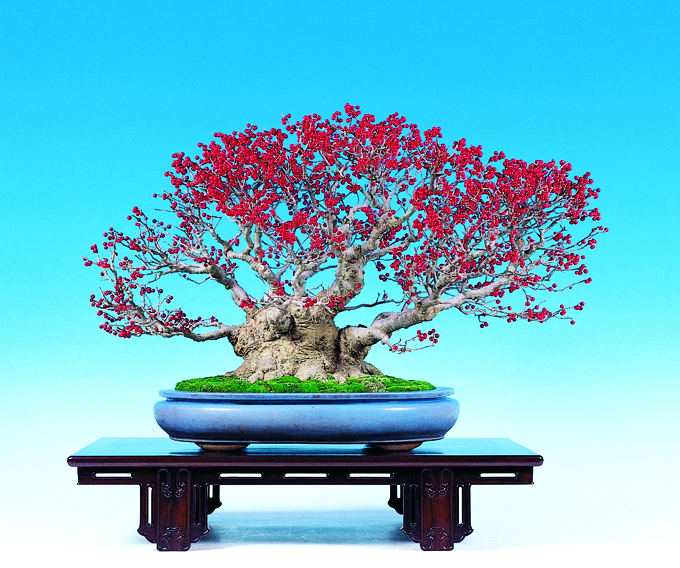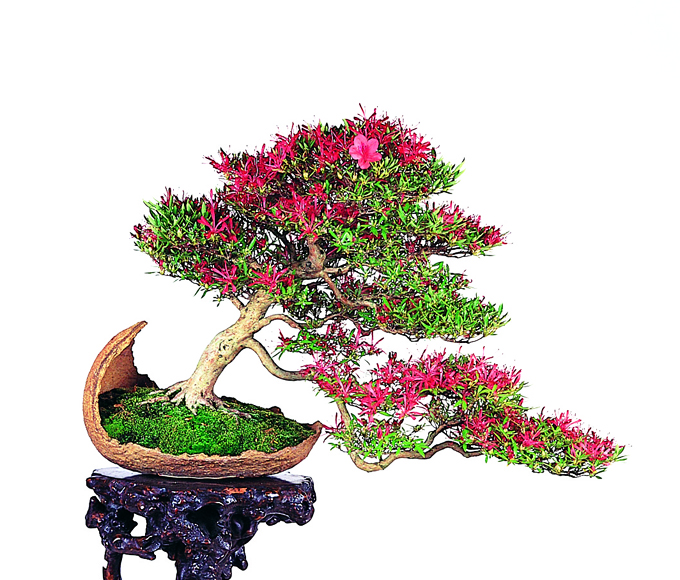 Aside from the very distinctive shari and jin (two types of deadwood), there are a couple other things about this Japanese white pine that you may have already noticed. First it seems somewhat top-heavy, and second, this top-heavy quality is exaggerated by the pot, which is quite small relative to the size of the tree. Still, amazingly it works quite well. Even better than quite well.
Aside from the very distinctive shari and jin (two types of deadwood), there are a couple other things about this Japanese white pine that you may have already noticed. First it seems somewhat top-heavy, and second, this top-heavy quality is exaggerated by the pot, which is quite small relative to the size of the tree. Still, amazingly it works quite well. Even better than quite well.
The bonsai shown here are all from a gallery in Bonsai Today issue 96. Reminds me of the older galleries from the very earliest Bonsai Todays. How important they were back in the dark ages before the internet, when there weren’t so many readily available photos of world-class bonsai. Without seeing what high quality trees look like, it’s almost impossible to improve your own trees.
This exposure to quality bonsai was brought home when I recently studied for a few days with Michael Hagedorn. First thing every morning before setting to work, we’d drink tea and look at Kokufu albums. In addition to being a congenial way to start the day, looking at those amazing trees provided inspiration for the work that followed.
 Azaleas don’t grow like this in nature, but nevertheless, you often seem them shaped in this pine-like fashion. Beyond that anomaly, there are at least a couple things to really like about this tree, not the least of which is the trunk’s muscular, flowing base and the flower-to-foliage balance (sometimes azaleas are completely covered with flowers; a different look for sure).
Azaleas don’t grow like this in nature, but nevertheless, you often seem them shaped in this pine-like fashion. Beyond that anomaly, there are at least a couple things to really like about this tree, not the least of which is the trunk’s muscular, flowing base and the flower-to-foliage balance (sometimes azaleas are completely covered with flowers; a different look for sure).
 An old Ume modoki (Japanese winterberry) with several smaller trunks growing out of one very fat old trunk. Winterberry are prized in Japan, in part because, as the name implies, they tend to hold their brilliant red berries all winter.
An old Ume modoki (Japanese winterberry) with several smaller trunks growing out of one very fat old trunk. Winterberry are prized in Japan, in part because, as the name implies, they tend to hold their brilliant red berries all winter.
 This is a very distinctive Azalea. First, windswept azaleas are not all that common (have you ever seen one?). Then there’s the bright white deadwood that snakes it’s way up the main trunk and to some extent at least, up the other two trunks as well. Again, something you don’t often see on azaleas. This photo and all of the other photos in this post are from Bonsai Today issue 96 (now 75% off at Stone Lantern).
This is a very distinctive Azalea. First, windswept azaleas are not all that common (have you ever seen one?). Then there’s the bright white deadwood that snakes it’s way up the main trunk and to some extent at least, up the other two trunks as well. Again, something you don’t often see on azaleas. This photo and all of the other photos in this post are from Bonsai Today issue 96 (now 75% off at Stone Lantern).
 Does this azalea feel like it’s going to fall over? I think this feeling is created in part by the first branch; the way it reaches so far to the right while dipping down all the way to the bottom of the pot. If you cover that branch with your hand, you’ll see a very nice bonsai that seems more stable. Still, there’s something dynamic about the tension that this leaning tree sets up.
Does this azalea feel like it’s going to fall over? I think this feeling is created in part by the first branch; the way it reaches so far to the right while dipping down all the way to the bottom of the pot. If you cover that branch with your hand, you’ll see a very nice bonsai that seems more stable. Still, there’s something dynamic about the tension that this leaning tree sets up.
 It wasn’t my intention to turn this into an azalea gallery, but I couldn’t resist this one. It serves as a contrast to first azalea’s ‘flower-to-foliage balance.’ And then there’s the bright blue background which no doubt serves to set off the flowers, though I’m not so sure that this isn’t overkill. Perhaps a more subtle background (eg the windswept azalea above) would be a little easier on the eyes and better serve the tree.
It wasn’t my intention to turn this into an azalea gallery, but I couldn’t resist this one. It serves as a contrast to first azalea’s ‘flower-to-foliage balance.’ And then there’s the bright blue background which no doubt serves to set off the flowers, though I’m not so sure that this isn’t overkill. Perhaps a more subtle background (eg the windswept azalea above) would be a little easier on the eyes and better serve the tree.
All of the photos in this post are from Bonsai Today issue 96 (now 75% off at Stone Lantern). If you would like to explore Japanese pines or Satsuki azaleas more, Stone Lantern also offers our Masters’ Series Japanese Black and White Pines and Robert Callaham’s Satsuki Azaleas. Both books are currently discounted.